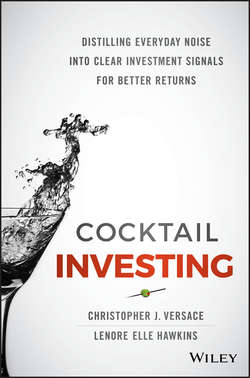Читать книгу Cocktail Investing - Hawkins Lenore Elle - Страница 7
На сайте Литреса книга снята с продажи.
Chapter 1
Money
Savings and Debt
ОглавлениеBob thought he'd been exceptionally responsible. He'd put funds away every month for most of his adult life and proudly avoided investing in the stock market, believing his friends who did were essentially gambling. He's not alone in that. In Italy, the older generations do not even refer to investing in stock and bonds with the proper translation, “investire in borsa,” but rather more often use the term, “giocare in borsa,” which literally means “gambling on the stock exchange.”
Even if you think you have it covered, the harsh reality is that many of us, like Bob, simply may not be as prepared as we think. Even for those who have been saving for a long time and are ahead of the 31 percent of U.S. adults who have no savings or pension plan1 it may not be enough. According to Bankrate.com, even 46 percent of the highest-income households ($75,000+ per year) and 52 percent of college graduates lack enough savings to cover a $500 car repair or $1,000 emergency room visit.2 Did you know the cost of raising a child through the age of 18 in either the United States or Canada is more than $240,000?!? In the United Kingdom, that number is $342,000.3 A recent report by AMP and the National Centre for Social and Economic Modeling in Australia found that the cost of raising two children to the age of 21 in that country rose more than 50 percent between 2007 and 2013 is now about $720,000. No wonder people are having fewer and fewer kids in the Western world!
And it can be more, a lot more. Those are only the averages!
We'd point out that excludes the cost of college, let alone if they get into an Ivy League! According to the College Board, a “moderate” college budget for an in-state public college for the 2013–2014 academic year averaged $22,826, while a moderate budget at a private college averaged $44,750. Some quick math puts that four-year cost between $91,000 and $180,000, but that's just the education part – room, board, and other items are extra. That's a pretty penny if you only have one child; if you have two or more children, it could easily cost over $1 million to raise them into their early twenties.
Trust us, you are not alone in looking at that cost.
According to the Consumer Financial Protection Bureau (CFPB), more than 40 million Americans are working to repay more than $1.2 trillion in outstanding student loan debt, and we're sorry to say the conventional wisdom on this is wrong in the United States. What's the conventional wisdom, you ask? Well, the herd (we'll have more on who that is and why they tend to miss what's really going on later) view is that all these people struggling to pay off student loans are young people, primarily recent college graduates.
They're not.
A report by the New York Federal Reserve showed that in 2012, the last year for which there are records, 4.7 million people who owe money on student loans are between the ages of 50 and 59. Perhaps more of a surprise – 2.2 million are age 60 and older!
Is it hard to fathom then that 40 percent of Americans past the age of 45 said they had thought “only a little” or “not at all” about financial planning for retirement? No – lest you think we are making it up, that was revealed in a 2014 Federal Reserve Board study.
According to the OECD (Organization for Economic Co-Operation and Development), the ratio of household debt to income in the Eurozone has gone from 77.2 percent in 2002 to 97 percent in 2013. In Italy, this ratio has risen from 37.7 percent to 65.8 percent in 2012; but that isn't nearly as bad as in Spain where debt has gone from 79.3 percent of household income to 122.9 percent by 2012. In the United States, in 2000 this same ratio was about 90 percent. It peaked at 133.6 percent in the fourth quarter of 2007 (no surprise, given all those crazy 0-percent-down mortgages being handed out left and right, coupled with the home equity credit lines that became ATMs for many) but has improved to now be about 108 percent by 2015.
Figure 1.1 Total liabilities to disposable income4 ratio for households and nonprofit organizations
For argument's sake, let's say that you've been a diligent person and you're socking some of your after-tax dollars every month as best you can, to chip away at that looming cost.
If at this point you understand that you will need to invest to ensure you meet your financial goals, you can skip to Chapter 2; just be sure to check the summary located at the end of this chapter.
1
31 percent of Americans have no retirement savings at all.
2
http://www.prnewswire.com/news-releases/63-of-americans-cant-afford-500-car-repair-or-1000-emergency-room-visit-300200097.html.
3
Rebecca Smithers, “Cost of Raising a Child Rises to £218,000,” The Guardian (January 26, 2012). Retrieved August 12, 2012. www.theguardian.com/money/2012/jan/26/cost-raising-child-rises-218000.
4
Disposable personal income is total personal income less personal income taxes.
Source: St. Louis Federal Reserve
